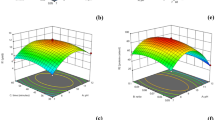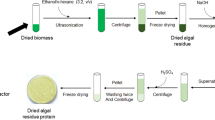Abstract
The purpose of this study was to evaluate the effectof pH on the extraction of protein nitrogen from Atriplex lampa leaves (Moquin) Dietrich. Thechemical characterization of the dry matter indicated thefollowing (g/100 g): protein, 26.93; ash, 21.80; etherextract, 4.65; dry matter, 37.30; sodium, 6.05; and calcium, 0.41.Non-critical values were obtained for saponins andnitrates. The high concentration of oxalic acid (8.52 g/100 g),together with elevated salt content accountfor the low palatability of the studied species.In order to determine the parameters needed to improvethe extraction in protein nitrogen from leaves, freshmaterial was macerated with 2% sodium metasulfite,followed by pulping with a hand-driven grinder.Extractions were performed at different pH values(2–12) adjusting the value with 5N HCL or NaOH, withagitation followed by centrifugation and pressing.Supernatants were collected and kept. The lastextraction was performed with Tween 20 in order toobtain maximum nitrogen recovery from the residuecake. Highest extraction (41.23%) was obtained at pH10 with a 1:5 ratio (leaf : deionized water, w/v). Itis proposed that this regional natural resource may beused to elaborate a protein concentrate, which can bemade more palatable by decreasing potassium and sodiumsalt content with the use of membrane technology.
Similar content being viewed by others
References
Múlgura de Romero ME (1981) Darwiniana 23 (1): 119–150.
Pasternak D, Aronson JA, Ben-Dov J, Forti M, Mendlinger S, Nerd A, Sitton D (1986) Development of new arid zone crops for the Negev desert of Israel. J Arid Environments 11: 37–59.
Marcarian V, Vera Cruz MT, Cardoso de Matos G (1990) Some considerations regarding selection of forage species for Cape Verde. Investigaçao Agrária 3 (3): 76–79._INIDA, Praia, Cape Verde.
Roig FA (1981) Flora de la Reserva Ecológica de Ñacuñán, Instituto Argentino de Investigaciones de las Zonas Aridas, Mendoza, Argentina. Editorial Zeta. Cuaderno Técnico 3: 60–80.
De Kock GC (1980) Drought resistant fodder shrub crops in South Africa. In Le Houérou HN (ed), Browse in Africa, the current state of knowledge, pp. 399–408._Paris: Unesco.
Byers M, Sturrock JW (1971) Amino acid composition and in vitro digestibility of some protein fractions from three species of leaves of various ages. J Sci Food Agric. 22: 242.
Stafford AE, Bolin HR (1972) Food Eng 44: 128–136.
Festenstein GN (1961) Extraction of Protein from green leaves. J Sci Food Agric 12: 305–311.
AOAC (1990) Official methods of analysis, 15th edn. Arlington, VA: Association of Official Analytical Chemists.
Montes Adolfo Leandro (1981) Bromatología. Buenos Aires: Ed. Eudeba.
Wernimont G, Spendly W (1993) Use of statistics to develop and evaluate analytical methods. Arlington, VA: Association of Official Analytical Chemists.
Ure AM, Mitchell RL (1975) Lithium, sodium, potassium and cerium. In Dean JA, Rains TC (eds), Flame emission and atomic absorption spectrometry, Vol. 3. New York: Marcel Dekker.
Welcher FJ (1966) Standard methods of chemical analysis, Vol. III B.Instrumental Analysis, 6th edn. New Jersey: Van Nostrand Company, pp. 110.
Prosky L, Asp NG, Schweizer TF, Devries JW, Furda Y (1988) Determination of insoluble, soluble and total dietary fiber in foods and food products. J Assoc Off Anal Chem 71: 1017–1023. 259
Cataldo DA, Haroon M, Schrader LE, Youngs VL (1975) Rapid colorimetric determination of nitrate in plant tissue by nitration of salicilyc acid. Commun. Soil Sci Plant Anal 6: 71–80.
do Prado VC, Antunes PL, Sgarbieri VC (1980) Antinutrients occurrence and some physicochemical properties of the protein fractions of five Brazilian soybean varieties. Arch Latinoamer Nutr 30: 551–563.
Das Gupta BR, Boroff DA (1968) Separation of toxin and hemagglutin from crystalline type. A by anion exchange gel chromatography and determination of their dimension by gel filtration. J Biol Chem 234: 1065–1072.
Duarte Correa A, Jokl L, Carlsson R (1986) Chemical constituents, in vitro protein digestibility and presence of antinutritional subtance in amaranth grains. Arch Latinoamer Nutr 36: 319–326.
WHO/PHARM/92559 (1992) Quality control methods for medicinal plant material Switzerland, pp. 36–37.
Lu PS, Kinsella JE (1972) J Food Sci 37: 94.
Stahmann MA (1963) Ann Rev Plant Physiol 14: 137.
Lexander K (1970) Ann Appl Biol 66: 193.
Devi AV, Rao NAN, Vijayaraghvan PK (1965) Isolation and composition of leaf protein from certain species of Indian flora. J Sci Food Agric 16: 116.
Pasiecznik NM, Vera Cruz MT, Harris PJC (1996) The current status of Atriplex on the Cape Verde Islands. J Arid Environ 34: 512.
Silva E, Pereira C (1976) Aislación y composición de las proteínas de hojas de Atriplex nummularia y Atriplex repanda. Ciencia e Investigación Agraria 3: 166–174.
Carlsson R, Hallqvist CW (1981) Atriplex hortensis L. revival of a spinach plant. Acta Agric Scand 31: 231.
Mucciarelli SL, Cid JA, Arellano ML, Fernández S, Muzaber J (1988) Biologic value of protein concentrate of Atriplex lampa. Complementary value to wheat flour. Arch Latinoamer Nutr 38: 844–851.
Gerloff ED, Stahmann MA (1965) Amino acids composition of leaf protein concentrates. J Agric Food Chem 13: 139–145.
Lugg JWH (1940) Plant protein. Adv Protein Chem 5: 229–239.
Smith AM, Agiza AH (1951) The amino acids of severd grass-land species, cereals and bracken. J Sci Food Agric 2: 503–511.
Author information
Authors and Affiliations
Rights and permissions
About this article
Cite this article
Fernández, S., Padilla, A. & Mucciarelli, S. Protein extraction from Atriplex lampa leaves: Potential use as forage for animals used for human diets. Plant Foods Hum Nutr 54, 251–259 (1999). https://doi.org/10.1023/A:1008148803544
Issue Date:
DOI: https://doi.org/10.1023/A:1008148803544




